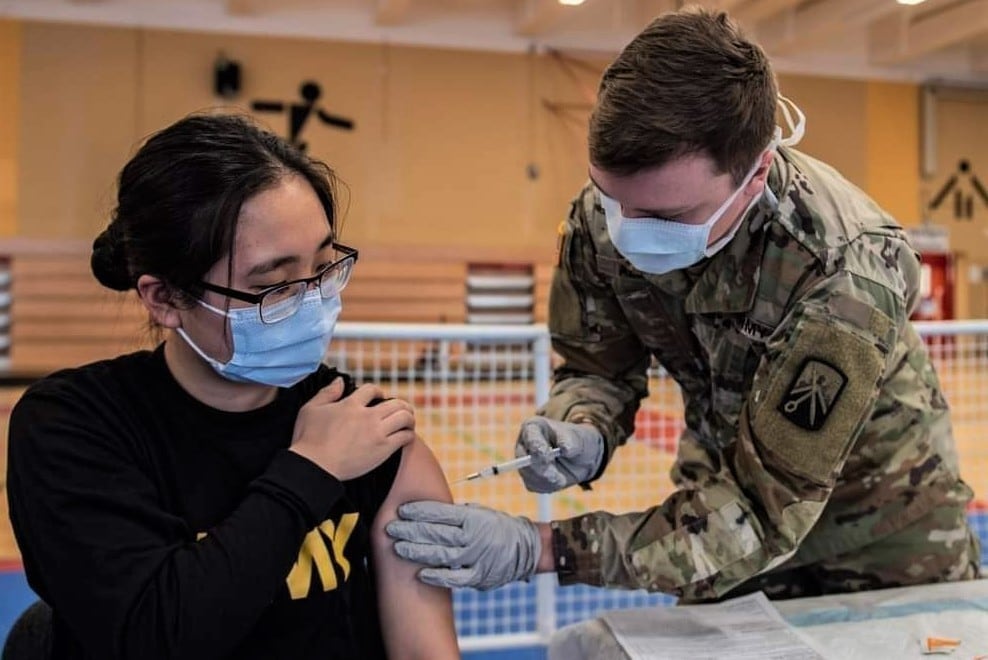It’s really hard to keep things really cold in a really hot place.
That was the first — and most urgent — issue facing Maj. Thomas Hudspeth when he learned he would be the logistical architect of the effort to administer COVID-19 vaccines to troops deployed across U.S. Central Command.
CENTCOM directs operations in 20 countries, from North Africa to Central Asia.
Hudspeth was serving as the deputy chief of staff for medical logistics with a deployed 3rd Medical Command headquarters element when the vaccination effort began in January.
The Moderna COVID-19 vaccine has to be stored at “-20 degrees Celsius,” which “was a constraint,” Hudspeth told Army Times during a Tuesday media roundtable.
So the medical logistics officer — who was once a science teacher — had his soldiers design and conduct experiments.
Their assignment: find out how to maintain a cold chain to prevent the vaccines from spoiling.
Hudspeth’s soldiers and the broader efforts of the command were successful. The 3rd Medical Command’s soldiers, nicknamed the “Desert Medics,” were able to administer more than 89,000 vaccines between January and July, according to Maj. Jeff Gruidl, a spokesperson for the unit.
RELATED

“If a servicemember was administered a COVID vaccine in theater, [our unit] was responsible for safely distributing, tracking and ensuring the vaccine was recorded,” said Col. Jennifer Marrast-Host, who commanded the deployed contingent of the 3rd Medical Command.
That Herculean logistical effort spanned “across multiple countries,” Gruidl said.
It also required the command to develop new systems and processes for tracking vaccine acceptance rates across the joint force.
One simple but key aspect of the plan that emerged, according to Marrast-Host, the commander, was ensuring that shots in transit didn’t spend unnecessary time out on the tarmac.
A large piece of their success was streamlining the supply chain in what Gruidl called “unprecedented ways.”
That included bypassing the Army’s medical logistics center in Europe in favor of using commercial carriers like FedEx to ship the shots directly into theater.
When it came to actually getting shots into arms, “we did mass vaccination [events] where we were vaccinating over 700 personnel per event,” Marrast-Host said.
By the time they received the Johnson & Johnson vaccine, which has less stringent temperature requirements, the demand had lessened for mass vaccination, Marrast-Host added.
One challenge they faced was avoiding thawing too many Moderna vaccine vials. They contain 10 doses, which must be used within 12 hours once punctured to draw the first dose.
“We had a strong idea as to how many people would be coming in at a specific time,” Marrast-Host explained. “At the end of the day...we would start counting by 10.”
If the last units scheduled to receive shots didn’t have a round number to open a final vial of vaccine, she explained, “we would then have those personnel report on a different day.”
As the command vaccinated more troops across the region, they began to notice a steady decrease in the amount of service member’s lost to COVID-19 quarantine or restriction of movement requirements.
“The more people were vaccinated, the less we were having outbreaks of COVID-19, which also led to less exposures [and] close contact tracing,” Marrast-Host noted.
Marrast-Host and her troops have since passed the torch to another unit. Their deployment ended in July so they won’t be the ones to vaccinate the remaining holdouts in CENTCOM.
Davis Winkie covers the Army for Military Times. He studied history at Vanderbilt and UNC-Chapel Hill, and served five years in the Army Guard. His investigations earned the Society of Professional Journalists' 2023 Sunshine Award and consecutive Military Reporters and Editors honors, among others. Davis was also a 2022 Livingston Awards finalist.




